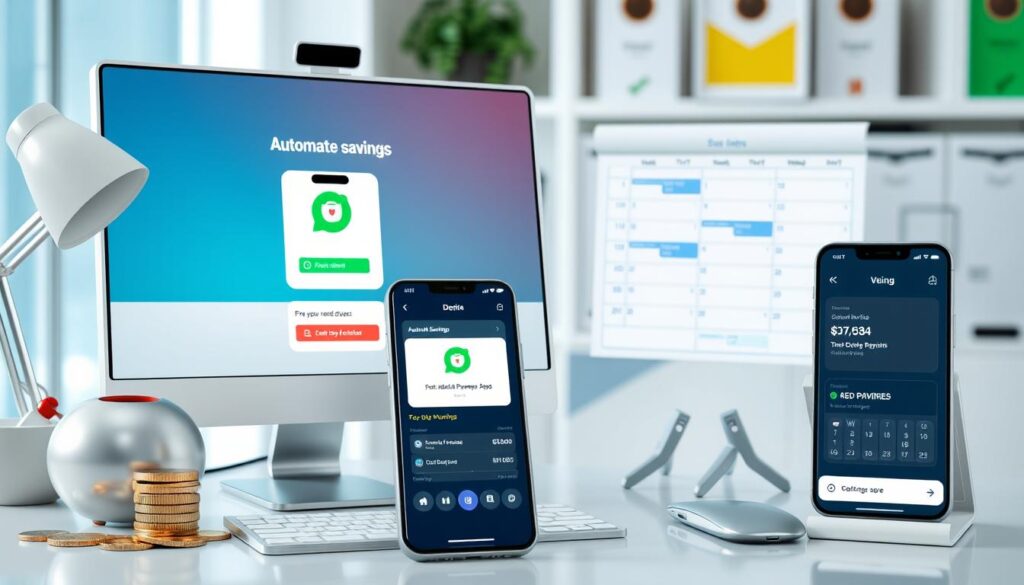Your first paycheck can bring excitement and uncertainty. Money management may seem tough, but it’s a vital skill. It can lead to financial freedom and peace of mind.
Personal finance basics are crucial today. Mastering money management strategies can set you up for success. It’s about making smart decisions that align with your goals.
Financial literacy is a lifeline in our complex economy. Understanding budgeting basics can help shape your future. Simple changes in your approach can greatly improve your financial health.
Key Takeaways
- Create a budget using the 50/30/20 rule for balanced spending
- Build an emergency fund covering 3-6 months of expenses
- Prioritize high-interest debt repayment
- Automate savings and bill payments for consistency
- Use budgeting apps to track spending patterns
- Set SMART financial goals for clear direction
- Start investing early, even with small amounts
Understanding the Fundamentals of Financial Planning
Financial planning shapes your financial future. It’s about making smart money decisions. Let’s explore why financial planning is crucial.
Why Financial Literacy Matters
Financial literacy helps you make wise money choices. Investopedia offers 36,000 articles on financial topics. Yet, 6% of U.S. households lack bank accounts.
Money knowledge aids in smart spending and saving. It helps build emergency funds and plan for retirement.
Basic Financial Concepts for Beginners
Start with savings accounts, checking accounts, and high-yield savings. Understand credit scores – they’re vital for many services.
Learn the 50/30/20 budget rule: 50% for needs, 30% for wants. The remaining 20% goes to savings and debt.
Building Strong Money Management Foundation
Create an emergency fund with three to six months of expenses. Start with $500 if that’s more achievable.
Focus on high-interest debts first when paying off balances. For retirement, use employer 401(k) matches.
“Financial planning is bringing the future into the present so you can do something about it now.” – Alan Lakein
Develop a positive money mindset and seek personal finance advice. These steps can transform your financial journey.
Master these basics to secure a brighter financial future. Good money habits lead to better financial health.
Create and Master Your Budget Before Month Begins
Planning your budget early is a smart money move. It helps you manage your finances better and reach your goals. Let’s explore how to make an effective budget and use the right tools.
Setting Up Your First Budget
Start by listing your income sources. For example, use $3,000 as your baseline if that’s your monthly take-home pay. Then, track your expenses for a month to see your spending habits.
This tracking will show where you can cut back and save more. It’s a key step in creating a solid budget.

Essential Budget Categories to Include
When making your budget, include these key categories:
- Necessities (50% of income): housing, utilities, groceries, transportation
- Wants (30% of income): entertainment, dining out, hobbies
- Savings and debt repayment (20% of income): emergency fund, retirement savings, debt payments
Try to save at least $500 for your starter emergency fund. Over time, build it up to cover several months of basic living costs.
For retirement, aim to save 15% of your gross income. This will help secure your financial future.
Tools for Budget Planning
Use budgeting apps to simplify your financial planning and expense tracking. These tools can help you manage your money better.
- Monitor spending in real-time
- Set alerts for category overspending
- Prioritize bills and savings goals
- Visualize your progress through charts and graphs
Master these budgeting strategies to achieve financial success. Review and adjust your budget often to stay on track with your goals.
Track Every Dollar with Zero-Based Budgeting
Zero-based budgeting helps manage money effectively. It assigns a purpose to every dollar. Your income minus expenses should equal zero each month.
Start by listing all income sources. Then, allocate each dollar to specific categories. These may include rent, groceries, and savings.
The goal is to account for all your money. This method differs from traditional budgeting approaches.
You reassess expenses monthly instead of using past data. This improves cash flow management and expense tracking.
“Zero-based budgeting encourages financial intentionality and proactive planning.”
Here’s why it works:
- Full financial awareness
- Flexibility to adjust for income changes
- Goal-oriented financial planning
Create a new budget each month to stay on top of changing expenses. It’s okay to make adjustments as needed.
Keep tracking and stay committed to your financial goals. This approach will help you manage your money better.
Implementing the 50/30/20 Rule for Smart Money Management
The 50/30/20 rule helps manage money wisely. It splits after-tax income into three categories. This simple approach makes budgeting easier for many people.

Allocating 50% for Necessities
Half your income covers essential needs. This includes rent, groceries, utilities, and minimum debt payments. For an average U.S. household, about $2,703 covers these basics.
Managing 30% for Lifestyle Choices
30% goes to wants that improve your life. This might include dining out, entertainment, or new gadgets. With median income, you’d have $1,622 for these expenses.
Securing 20% for Financial Goals
The final 20% builds your financial future. Use it for savings, investments, and extra debt payments. On average, this amounts to $1,081 monthly.
The 50/30/20 rule may need adjusting for your situation. In expensive areas, necessities might exceed 50% of income. Find a balance that works while prioritizing savings and debt reduction.
“The 50/30/20 rule isn’t just about dividing your money – it’s about creating a sustainable financial future.”
Only 39% of Americans can cover a $1,000 emergency. Using this budgeting technique helps build financial stability. It’s a big step towards achieving financial freedom.
Building an Emergency Fund for Financial Security

An emergency fund is vital for financial security. It helps you handle unexpected costs without debt. Sadly, only 44% of Americans can cover a $1,000 emergency from savings.
Start small when building your fund. Set a goal to save $500 to $1,000 at first. This can cover minor emergencies like car repairs or small medical bills.
As you progress, aim to save 3-6 months of living expenses. This will provide long-term security for bigger financial challenges.
Here are some effective saving strategies to boost your emergency fund:
- Set up automatic transfers from your paycheck to a separate savings account
- Use high-yield savings accounts to earn more interest on your deposits
- Save extra income from bonuses or side hustles
- Track your progress with savings apps to stay motivated
Use your emergency fund wisely. Keep it for true emergencies like job loss or major home repairs. Don’t dip into it for regular expenses or non-essential items.
By following these tips, you’ll build a strong financial safety net. This will give you peace of mind in uncertain times.
“An emergency fund isn’t just a savings account; it’s peace of mind in times of uncertainty.”
Smart Strategies for Debt Management and Reduction
Tackling debt can feel overwhelming, but you can regain control of your finances. The average American household carries $101,915 in debt, including mortgage debt. This burden impacts more than just your wallet – it affects your overall well-being.
Prioritizing High-Interest Debt
Focus on high-interest debt first. Credit card balances often have the highest rates, making them a prime target. Paying these off first saves money on interest charges and improves credit management.

Creating a Debt Repayment Plan
Develop a solid plan for debt reduction. Consider these popular methods:
- Debt Snowball: Pay off smallest debts first for quick wins
- Debt Avalanche: Target highest interest rates to save more long-term
Whichever method you choose, stick to it. Consistency is key in debt management.
Avoiding New Debt Traps
While reducing debt, it’s crucial to avoid new debt. Create a budget using the 50/30/20 rule: 50% for needs, 30% for wants, 20% for savings and debt repayment.
This balance helps prevent overspending and accumulating more debt.
“The first step to getting out of debt is to stop digging.”
Effective debt management isn’t just about paying bills. It’s about changing habits and making smarter financial choices. With patience and persistence, you can achieve your debt reduction goals.
20 Essential Money Management Tips for Beginners

Smart money management is key to financial success. These tips will help you improve your finances and reach your goals.
Track your spending carefully. Group expenses into categories. Use bank statements to see where your money goes.
Set clear financial goals. Make them specific, measurable, and time-bound. These goals will guide your planning and keep you motivated.
Pick a budgeting method that suits you. Popular options include:
- Zero-based budgeting
- 50/30/20 rule
- Envelope budgeting
Focus on needs before wants. Pay for essentials first to ensure stability. Use budgeting apps to make tracking easier.
Set up automatic savings transfers. Include contributions to retirement funds. This habit builds wealth over time.
Saving just $20 a week results in $1,040 saved in a year!
Update your budget regularly. Adjust as your finances change. Do a financial check-up every six months.
Think about working with a financial advisor. They can provide personalized advice. They’ll help tailor strategies to your goals.
Remember, good financial planning never stops. Stay committed to your budget. You’ll see big improvements in your finances over time.
Automating Your Savings and Bill Payments
Financial automation can transform your money management. It streamlines your finances and helps you reach goals faster. Setting up automated savings and bill payments is key.
Setting Up Automatic Transfers
Start by automating your savings. Many banks offer features to transfer income directly to savings accounts. Ally Bank provides multiple savings accounts with competitive rates for different goals.

Creating Multiple Savings Goals
Break down your savings into specific categories. You might have accounts for different purposes. These could include emergency funds, vacations, insurance, and children’s expenses.
- Emergency fund
- Vacation savings
- Insurance payments
- Children’s expenses
This method helps you allocate funds efficiently. It also allows you to track progress towards each goal.
Managing Recurring Bills
Automating bill payments is crucial. Set up autopay for consistent expenses like car payments and rent. Include utilities, phone, and internet services too.
- Car payments
- Rent or mortgage
- Utilities
- Phone and internet services
Many providers offer discounts for autopay. Cell phone companies might give $5 off monthly bills. Student loan servicers may reduce interest rates by 0.25%.
“Automating your finances allows you to focus on your long-term goals without getting bogged down in day-to-day money management.”
Review your automated transactions regularly. This ensures everything works correctly. It also helps you stay on top of your finances.
Mastering the Art of Expense Tracking
Expense tracking is a vital financial management skill. It reveals your spending habits and guides money decisions. By monitoring every dollar, you’ll gain insights into your financial health.

Begin by noting all your expenses, from coffee to rent. Use bank statements, credit card bills, and receipts. This gives a complete picture of your spending over 3-4 months.
Next, sort your expenses into categories like food, utilities, and transport. This step is crucial for developing strong budgeting skills. It shows where your money goes and where you can save.
- Use spreadsheets or budgeting apps to organize your data
- Track fixed expenses like rent and variable costs like groceries
- Don’t forget to include occasional expenses like car maintenance
Make expense tracking a regular habit. Update your records often. This practice will improve your financial management skills.
It will help you reach your money goals faster. Consistent tracking puts you in control of your finances.
“Tracking your expenses is like having a financial GPS. It shows you where you are and helps you navigate to where you want to be.”
Expense tracking is a powerful tool for financial success. It helps you make smarter choices with your money. Use it to achieve your financial dreams.
Understanding the Difference Between Needs and Wants
Knowing needs from wants is key to smart budgeting. This knowledge shapes healthy spending habits. It’s the base for wise money choices.
Identifying Essential Expenses
Needs are must-haves for basic living. They include food, housing, utilities, and basic clothes. Healthcare and transport are also needs.
Fast internet might be a need for remote work or study. Understanding these essentials builds a strong money base.
Managing Discretionary Spending
Wants improve life but aren’t vital. They include dining out, entertainment, fancy clothes, and new gadgets.
A study found millennials spent $374 on impulse buys in 30 days. Controlling these expenses is vital for good finances.
Making Informed Purchase Decisions
To make smart money choices, follow these steps:
- Evaluate if the item is necessary for daily life
- Check if it fits within your budget
- Assess if it aligns with your long-term goals
- Look for alternatives
The 50/30/20 rule helps balance spending. It suggests 50% for needs, 30% for wants, and 20% for savings.
This approach can guide your spending and boost your financial health.

Your financial decisions today shape your financial future tomorrow. Choose wisely between needs and wants.
Starting Your Investment Journey
Investing is crucial for building wealth. It may seem complex, but the right approach can lead to long-term financial success. Let’s explore key strategies to help you start investing.

Set clear investment goals first. Your goals will shape your strategy. For retirement, invest 15% of your gross income annually. Start with an emergency fund before investing.
Diversification is essential in investing. Spread your investments across different mutual funds to minimize risk. This strategy helps protect your portfolio from market fluctuations.
- Large-cap funds for growth and income
- Mid-cap funds for growth
- Small-cap funds for aggressive growth
- International funds for global exposure
Low-cost index funds or ETFs are great for beginners. They offer broad market exposure with lower fees. Robo-advisors can also help, charging about 0.25% for automated portfolio management.
“Successful investing is a journey, not a one-time event, requiring time and patience for learning and growth.”
Investing is a long-term game. Keep your money invested for at least five years. This approach allows you to benefit from compound growth.
As you gain confidence, explore more active investment strategies. Stay informed and review your portfolio regularly. Adjust your approach as your financial situation changes.
Planning for Retirement Early
Retirement planning secures your financial future. Starting early gives your money time to grow. Let’s explore key aspects of retirement planning for a comfortable future.
Understanding Retirement Accounts
401(k)s and IRAs are popular retirement savings options. 401(k)s are employer-sponsored, while IRAs are individual accounts. Both offer tax advantages for long-term investing.
Learning about these account types helps you make smart choices for your retirement savings strategy.
Maximizing Employer Contributions
Take full advantage of your employer’s 401(k) match. This free money can boost your retirement savings significantly. Try to contribute enough to get the full match.
Long-term Investment Strategies
Adopt a long-term investing approach for retirement planning. Consider these strategies:
- Diversify your portfolio to spread risk
- Regularly review and rebalance your investments
- Consider low-cost index funds for broad market exposure
- Adjust your investment mix as you get closer to retirement
The average American spends about 20 years in retirement. Start early and make smart decisions for a secure future.
“The best time to plant a tree was 20 years ago. The second best time is now.” – Chinese Proverb
This wisdom applies to retirement planning too. Begin today, regardless of your age. Your future self will be grateful.
Implementing Cash-Only Budgeting Methods
Cash-only budgeting can transform your money habits. It involves using physical cash for purchases. This creates a real connection with your spending.
By dividing your monthly income into categories, you gain better control. This method helps you manage your finances more effectively.
The envelope system is a popular cash-only budgeting approach. It’s simple to use and can be very effective.
- Divide your income into different envelopes for expenses like rent, groceries, and entertainment
- Use only the cash in each envelope for its designated purpose
- Stop spending in a category when the envelope is empty
This method prevents overspending and encourages smart financial choices. It works well for people living paycheck to paycheck. It’s also great for those saving for specific goals.
For example, someone earning $1,500 monthly might divide it like this: $600 for rent, $300 for groceries, and $150 for transportation.
Cash-only budgeting has many benefits. It can reduce credit card debt and increase awareness of spending habits. However, it also has some drawbacks.
Carrying large amounts of cash can be risky. You also miss out on potential interest from bank accounts. For a safer option, try apps that copy the envelope system.
“Cash stuffing has resurged in recent months, particularly among younger consumers who spend more time online.”
A cash-only budget can greatly improve your financial health. It helps you spend wisely and avoid debt. Try it out and see how it changes your money management skills.
Developing Healthy Money Habits
Strong money habits are crucial for financial success. Personal finance and financial mindfulness create a solid foundation for your future. These skills help you manage your money wisely.
Creating Financial Routines
Consistent routines shape positive money habits. Review your budget and track expenses weekly. Try to save 20% of your income by cutting nonessential costs.
Automated transfers between checking and savings make saving effortless. This method helps you build wealth without thinking about it.
Building Money Mindfulness
Be aware of your spending triggers and emotional connections to money. Try money-saving challenges like the 52-week challenge or a no-spend month. These activities can boost your savings quickly.
Remember, investments come with risks. Educate yourself before making any investment decisions. Knowledge is power in the financial world.
Setting Financial Boundaries
Clear financial boundaries help avoid overspending and peer pressure. Use the 50/30/20 rule: 50% for needs, 30% for wants, and 20% for savings. This balance helps manage finances while working towards goals.
“Financial freedom is available to those who learn about it and work for it.” – Robert Kiyosaki
Healthy money habits equip you for financial challenges. They lead to long-term success. Informed decisions, good habits, and commitment to goals create financial wellness.
Using Technology for Financial Management
Technology has transformed how we manage money. Financial apps and budget tools are now crucial for digital money management. These tools help monitor spending, set goals, and track progress easily.
Many financial apps connect to your bank and credit card accounts. They provide real-time updates on your finances without manual data entry. Useful features include:
- Bill payment reminders
- Savings goal tracking
- Investment monitoring
When selecting budget tools, prioritize security. Choose apps that protect your sensitive financial data. The National Endowment for Financial Education suggests saving 20% of take-home pay early in your career.
Many apps can automate this savings process for you.
“The increased use of digital payment methods over cash has reduced bank visits, with many banks enhancing their online presence and mobile apps.”
With the right apps, you can manage most transactions online or via phone. This includes fund transfers, bill payments, and balance checks. These digital tools give you better control over your finances.
They also help you make smarter decisions about your money. Embrace technology to improve your financial management skills.
Regular Financial Review and Adjustment Strategies
Regular financial reviews are crucial for effective money management. Set aside time monthly or quarterly to check your finances. This habit helps track progress and make smart budget adjustments.
During reviews, examine your spending habits for potential cutbacks. Cooking at home once weekly could save $1,300 annually. That’s over $50,000 in a 40-year career!
Your financial situation changes over time. Adjust your budget as your income fluctuates. A $6,000 salary increase might only mean $372 more monthly after taxes.
Use these insights to fine-tune your budget and boost savings. Stay flexible and proactive with your financial reviews. This approach will help you achieve your long-term money goals.

